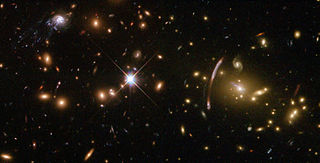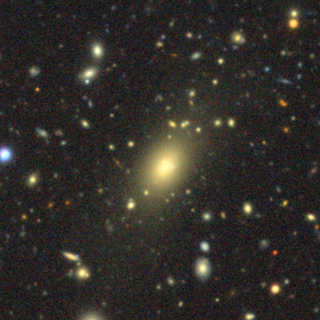
In astronomy, dark matter is a hypothetical form of matter that appears not to interact with light or the electromagnetic field. Dark matter is implied by gravitational effects which cannot be explained by general relativity unless more matter is present than can be seen. Such effects occur in the context of formation and evolution of galaxies, gravitational lensing, the observable universe's current structure, mass position in galactic collisions, the motion of galaxies within galaxy clusters, and cosmic microwave background anisotropies.

Galaxy groups and clusters are the largest known gravitationally bound objects to have arisen thus far in the process of cosmic structure formation. They form the densest part of the large-scale structure of the Universe. In models for the gravitational formation of structure with cold dark matter, the smallest structures collapse first and eventually build the largest structures, clusters of galaxies. Clusters are then formed relatively recently between 10 billion years ago and now. Groups and clusters may contain ten to thousands of individual galaxies. The clusters themselves are often associated with larger, non-gravitationally bound, groups called superclusters.

An Einstein ring, also known as an Einstein–Chwolson ring or Chwolson ring, is created when light from a galaxy or star passes by a massive object en route to the Earth. Due to gravitational lensing, the light is diverted, making it seem to come from different places. If source, lens, and observer are all in perfect alignment (syzygy), the light appears as a ring.

Abell 1835 IR1916 was a candidate for being the most distant galaxy ever observed, although that claim has not been verified by additional observations. It was claimed to lie behind the galaxy cluster Abell 1835, in the Virgo constellation.

Abell 2667 is a galaxy cluster. It is one of the most luminous galaxy clusters in the X-ray waveband known at a redshift about 0.2.

The Bullet Cluster consists of two colliding clusters of galaxies. Strictly speaking, the name Bullet Cluster refers to the smaller subcluster, moving away from the larger one. It is at a comoving radial distance of 1.141 Gpc.

Abell 520 is a galaxy cluster in the Orion constellation, located at a co-moving radial distance of 811 Mpc (2,645 Mly) and subtends 25 arcminutes on the Earth sky.

HCM-6A is an LAE galaxy that was found in 2002 by Esther Hu and Lennox Cowie from the University of Hawaii and Richard McMahon from the University of Cambridge, using the Keck II Telescope in Hawaii. HCM-6A is located behind the Abell 370 galactic cluster, near M77 in the constellation Cetus, which enabled the astronomers to use Abell 370 as a gravitational lens to get a clearer image of the object.

While the presence of any mass bends the path of light passing near it, this effect rarely produces the giant arcs and multiple images associated with strong gravitational lensing. Most lines of sight in the universe are thoroughly in the weak lensing regime, in which the deflection is impossible to detect in a single background source. However, even in these cases, the presence of the foreground mass can be detected, by way of a systematic alignment of background sources around the lensing mass. Weak gravitational lensing is thus an intrinsically statistical measurement, but it provides a way to measure the masses of astronomical objects without requiring assumptions about their composition or dynamical state.

Abell 383 is a galaxy cluster in the Abell catalogue.

MACS J0416.1-2403 or MACS0416 abbreviated, is a cluster of galaxies at a redshift of z=0.397 with a mass 160 trillion times the mass of the Sun inside 200 kpc (650 kly). Its mass extends out to a radius of 950 kpc (3,100 kly) and was measured as 1.15 × 1015 solar masses. The system was discovered in images taken by the Hubble Space Telescope during the Massive Cluster Survey, MACS. This cluster causes gravitational lensing of distant galaxies producing multiple images. Based on the distribution of the multiple image copies, scientists have been able to deduce and map the distribution of dark matter. The images, released in 2014, were used in the Cluster Lensing And Supernova survey with Hubble (CLASH) to help scientists peer back in time at the early Universe and to discover the distribution of dark matter.
Abell 2152 is a bimodal galaxy cluster and one of three clusters comprising the Hercules Supercluster. It contains 3 BCGs; the S0 lenticular UGC 10204, the pair UGC 10187, and the SA0 unbarred lenticular CGCG 108-083. In total there are 41 galaxies which are confirmed to be members of the cluster. The cluster is classified as a Bautz-Morgan type III and Rood-Sastry class F cluster, indicating morphological irregularity and perhaps dynamical youth. It is receding from the Milky Way galaxy with a velocity of 12385 km/s.

Abell 1201 BCG (short for Abell 1201 Brightest Cluster Galaxy) is a type-cD massive elliptical galaxy residing as the brightest cluster galaxy (BCG) of the Abell 1201 galaxy cluster. At a redshift of 0.169, this system is around 2.7 billion light-years from Earth, and offset about 11 kiloparsecs from the X-ray peak of the intracluster gas. With an ellipticity of 0.32±0.02, the stellar distribution is far from spherical. In solar units, the total stellar luminosity is 4×1011 L☉ in SDSS r-band, and 1.6×1012 L☉ in 2MASS K-band. Half the stars orbit within an effective radius of 15 kpc, and their central velocity dispersion is about 285 km s−1 within 5 kpc rising to 360 km s−1 at 20 kpc distance.

Georges Meylan is a Swiss astronomer, born on July 31, 1950, in Lausanne, Switzerland. He was the director of the Laboratory of Astrophysics of the Swiss Federal Institute of Technology (EPFL) in Lausanne, Switzerland, and now a professor emeritus of astrophysics and cosmology at EPFL. He is still active in both research and teaching.

Abell 2219 BCG, also known as LEDA 2285869, is a massive type-cD elliptical galaxy residing as the brightest cluster galaxy (BCG) in the Abell 2219 galaxy cluster located in constellation Hercules. At the redshift of 0.224, the galaxy is around 2.7 billion light-years from Earth.

Abell 697 BCG, also known as LEDA 2079433, is a massive type-cD elliptical galaxy residing as the brightest cluster galaxy in Abell 697 galaxy cluster. It is located in the constellation of Lynx and has a redshift of 0.28, meaning the galaxy is located 3.5 billion light-years away from Earth.

Abell 68 is massive and rich galaxy cluster located in the constellation of Pisces with a projected co-moving distance of approximately 1124.6 Mpc or 3.668 billion light-years away from Earth. The cluster is especially notable for its gravitational lensing and was first discovered by George O. Abell in 1958.















